I have a ton of Pinterest pins for Fashion Inspiration, so I
try to actually use them for inspiration as much as possible!
Here is a project based on Pinterest and
using a thrifted sweater.
 |
| Inspiration photo from Pinterest |
I’ve had this photograph pinned on Pinterest for a while now
so last weekend I decided to tackle it!
Pinterest isn’t letting me click through to the original source for this
photo.
I found a rather simple navy blue sweater at my local
Salvation Army. It’s nothing special, no
special materials or anything, but it is very soft, fits well and has a fine
knit. It is also in great shape: no
tears, pulls, or stains, it has retained its shape and isn’t too pilly.
 |
| Original sweater |
I purchased 1 yard of pink ribbon at my go-to fabric store.
The sweater was $4.50 and the ribbon was $1.65.
I already had matching thread, so I got a new and very unique sweater
for less than $7!
How to:
1. Cut through the neckline and on either side of
the shoulder seam to as far down the arm as you want. Remove the bulky shoulder seam.
 |
| Cut a slit at the shoulder |
2. Carefully, and without stretching the knit, stay
stitch about 1/8 inch from the edge to stabilize it and keep the edge from unraveling
while you work.
 |
| Stay stitch the raw edge |
3. Cut the ribbon in half so you have two ties.
4. Gently and without stretching the fabric, fold
the seam over, laying the ribbon in as you go.
As I got closer to the end of the slit, my seam became less of a fold
and more of a roll.
Just be sure to get
the raw edge tucked inside the seam.
Also, if your new shoulder slit crosses any seams, be sure to keep them
aligned as you fold over the raw edge.
 |
| Pinned seam with the ribbon pinned into the seam |
5. I decided to hand baste the seam as the raw edge
kept wanting to peek out between the pins and the pins were getting bulky.
Basting the edge kept the seam super secure
for the machine sewing.
I chose a small stitch, a size 2 on my
machine.
I had to advance it by hand to
work it over the neck seam.
 |
| Here you can see the hand basting |
6. Remove your hand basting and gently press the
seam with a warm iron.
7. Finish the seam on the ends of the ribbon.
Fold ¼ inch of the raw edge of the ribbon,
press with the iron, then fold and press ¼ inch again.
Unfold and trim the edge to 1/8 inch of the
first fold and clip the corners.
Fold
the seam again, pin, sew, and press.
 |
| Clip the corners of the seam |
8. The ribbon needs to be stitched down to the
underside of the seam.
Here it is coming
out of the finished sweater seam on the wrong side of the sweater, but it needs
to lay flat along the seam.
 |
| The ribbon, sewn into the finished seam |
 |
| Pin the ribbon so it lays flat against the seam (wrong side) |
9. Use thread
to match your sweater in the needle, and thread to match the ribbon in your
bobbin.
Pin the ribbon flat along the seam,
and stitch right on top of your first seam.
With the threads matching your sweater and ribbon, this seam will
blend.
 |
| Sew the ribbon flat to the seam |
10. Press gently with a warm iron and voila!
 |
| Finished sweater |
 |
| Love the bare shoulder peeking out! |
I also removed the sweater’s original and kinda ugly tag
from the back of the neckline.
The
machine care instructions are in the side seam and those I kept.
I think this would also be pretty with a longer slit down
the arm, and lace inset into the slit up to the shoulder bow. This would be a great solution to a sweater
that fits in the body, but the arms are too slim. Hmmmm…going to have to find another thrift
store sweater now!!
Loving it with my new pale pink pumps!!



















































